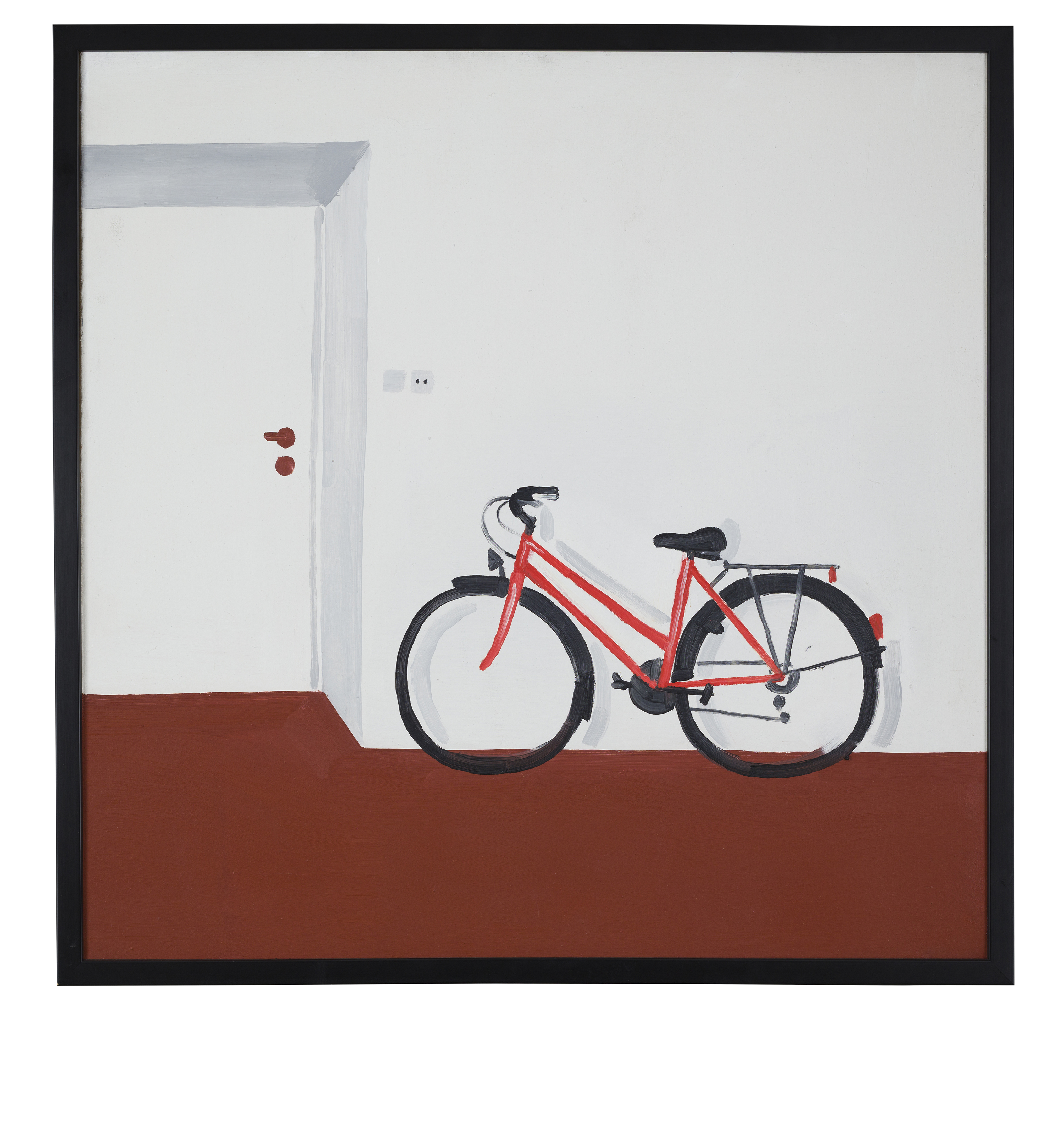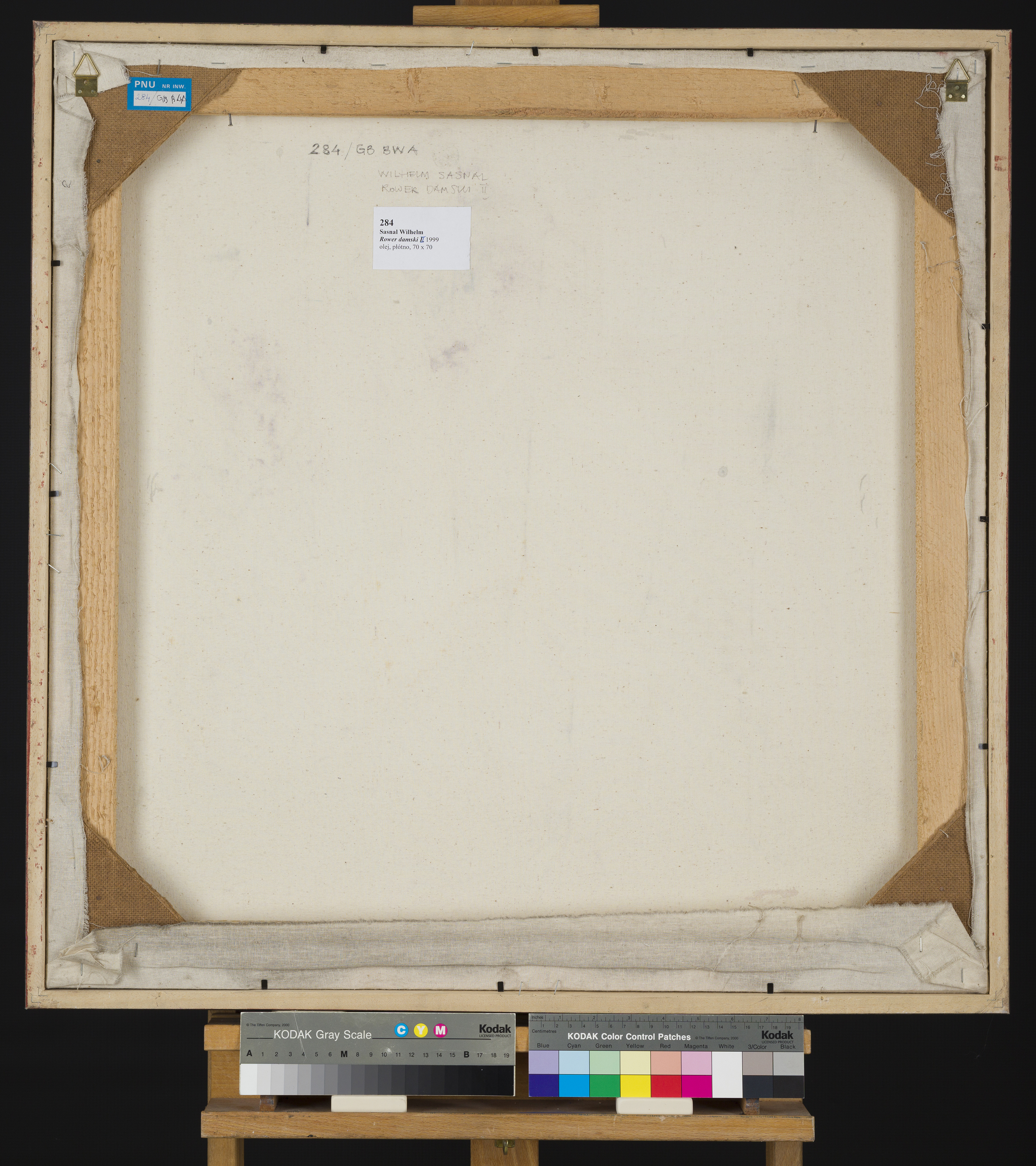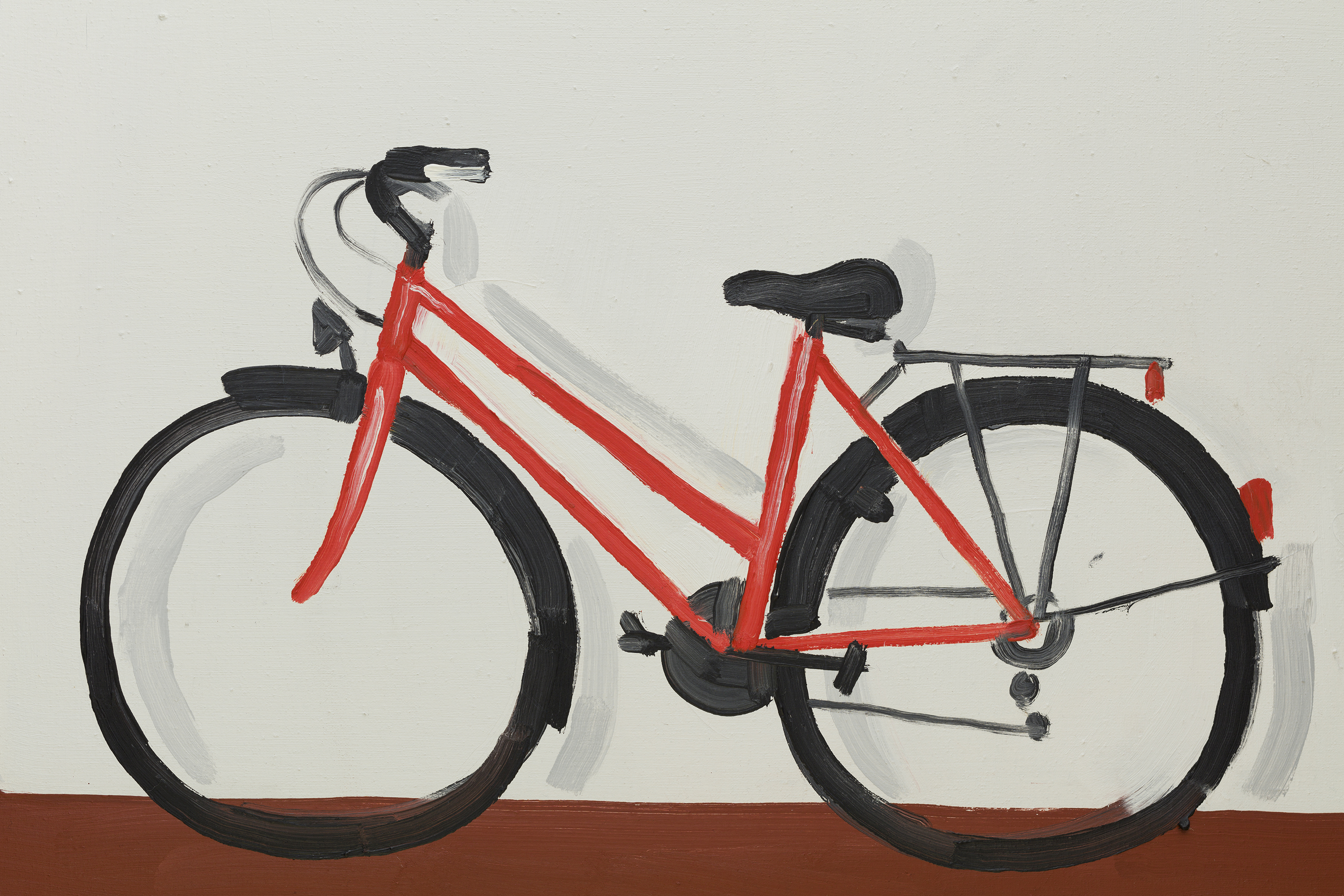Ladies’ Bicycle
- Date
- 1999
- Type of object
- Painting
- Technique
- oil, canvas
- Dimensions
- 70 x 70
- Date of acquisition
- 1999
- Catalogue no.
- 285
- Additional information
Grand Prix of BIELSKA JESIEŃ and the award of Ministry of Culture and National Heritage



Description
A painting in white, red and brown, flat colour application. In the foreground: a ladies’ bike, black with red parts, placed against a wall of an apartment. Monochromatic reddish brown floor. The wall, the door-recess and the door in the shades of white and grey. Noticeable details: door handle and electric sockets in the wall.
Interpretation
Wilhelm Sasnal Ladies’ Bike, Men’s Bike, diptych Propped against the wall by the door stand two bicycles: a red ladies’ bike and a gray men’s bike. The interior, if much simplified, is typical of a block of flats. Two independent paintings show the same scene, and only the main ‘characters’ change. In the era of political correctness, the terms “ladies’” and “men’s” don’t have a chauvinist ring, but represent a division into two clearly defined categories, in this case of a bicycle. The bikes constitute the only difference in the unified world, represented here by the same dark walnut floor, door recess and door with a plastic handle. No individual characteristics, distinguishing inscriptions or signs. The diptych evokes simplicity of juxtaposed forms and a nonchalance of drawing, whilst at the same time radiating mastery: you can see the hand of an experienced painter, able to create an illusion of depth with just a trapezium, a triangle and a couple of brush strokes; or depict a whole set of shiny, three dimensional bike parts by a few daubs of white paint on the red bicycle frame. Though simplified, the painting has all the details: mudguards, rear rack, lights, brakes, saddle spring, chain and gears in the well-equipped ladies’ bike, or a dynamo on the front wheel of the ascetic men’s bike – they’re all there. It’s easy to recognize the bike types with the gentle lines in the ladies’ bike and the angular shapes in the men’s bike. The bicycles may belong to a sister and brother, mother and son, or a married couple ... But they can also be found in two different flats, possibly far apart, occupied by a couple of strangers. Even so, they still represent the same category, i.e. the cyclist. Whether men or women, bicycle owners enjoy exercise and are environmentally conscious, some of them may not even own a car. The bicycle is indicative of certain views. When Wilhelm Sasnal painted Bicycles in 1999, he was looking for a job, cycling everywhere with his wife Anka. The experience inspired him to create a comic book entitled Everyday Life in Poland in 1999-2001. The book also included a scene showing the artist painting Ladies' Bike and Men's Bike, which he completed in just two hours with a view to sending the work to painting competition ‘Bielska Jesień’. The artist’s big hope was to win the first prize which would allow him to paint freely for a year without having to look for work. And the dream came true.
Bibliography
– XXXIV Ogólnopolski Konkurs Malarstwa „Bielska Jesień ’99”, Galeria Bielska BWA; [wykaz prac] s. 57
– reprod.: „Relacje–Interpretacje”, nr 4/2010, „50 obrazów”, Galeria Bielska BWA, Bielsko-Biała, wewn. str. okładki
– Lokomotywa. Wpływ kultury na rozwój lokalny [książka], red. A. Smalcerz, Galeria Bielska BWA, Bielsko-Biała 2011, repr. s. 100
– Kolekcja Sztuki Galerii Bielskiej BWA [album], red. i oprac. G. Cybulska, Galeria Bielska BWA, Bielsko-Biała 2011, ss. 142, 143, 144-145, 243
– Kartka z reprodukcją pracy, nakład 250 szt., wyd. Galeria Bielska BWA, Bielsko-Biała 2013
– Notatnik Kulturalny, „Miejsce dla sztuki”. Koszęcin, publikowana reprod.: Wilhelm Sasnal „Rower damski”, red. Jan Picheta, Miesięcznik Społeczno-Kulturalny „Śląsk”, nr 11, listopad 2015, str. 77
– kalendarz na lata 2016–2017, reprodukcja prac, format A3, Galeria Bielska BWA, 2015
– Pokaz 4. Postscriptum [w:] Magazyn Samorządowy, „W Bielsku-Białej”, 19/2016, okładka (tył)
– E. Furtak, Pokaz 4. - postscriptum. Jak powstają kolekcje sztuki i dizajnu? [w:] Wyborcza.pl portal, http://bielskobiala.wyborcza.pl/bielskobiala/56,88025,20689240,Pokaz_4_postscriptum_Jak_powstaja_kolekcje_sztuki.html [dostęp 5.12.2016] – www.galeriabielska.pl
– Pokaz 4. postscriptum. Jak powstają kolekcje sztuki i dizajnu [dostęp: 10.09.2016]
– https://www.facebook.com/galeriabielska/photos/ms. ..; [dostęp: 20.09.2016].
Exhibitions
1999 – XXXIV Ogólnopolski Konkurs Malarstwa „Bielska Jesień ’99”, Galeria Bielska BWA; Grand Prix
2002/2003 – „Rowelucja”, Galeria Raster, Warszawa
2005 – „Kolekcja Galerii Bielskiej BWA”, Galeria Bielska BWA, Bielsko-Biała
2010 – „50 obrazów”, Galeria Bielska BWA, Bielsko-Biała
2011 – “Carpe diem” wystawa dzieł sztuki z Kolekcji Sztuki Galerii Bielskiej BWA, Apartamenty Sfera, Bielsko-Biała
2015 – „Miejsce dla sztuki”. Wystawa prac z Kolekcji Sztuki Galerii Bielskiej BWA, Kameralna Sala Koncertowa – dawna Kaplica Pałacowa, Koszęcin, siedziba Zespołu Pieśni i Tańca „Śląsk” im. Stanisława Hadyny (25.09– 31.12.2015)
2016 – Kolekcja Sztuki Galerii Bielskiej BWA. POKAZ 4. Postscriptum. Jak powstają kolekcje sztuki i dizajnu (1 – 18.09.2016)
2017 – „Doświadczenie ciała” – prace z Kolekcji Sztuki Galerii Bielskiej BWA w Bielsku-Białej Galeria BWA MOS w Gorzowie Wlkp. (7.10–12.11.2017)
2019 – „Korzenie współczesności”, Sosnowieckie Centrum Sztuki – Zamek Sielecki (6.09–6.10.2019)
2022 – PODWÓJNOŚĆ. Wystawa prac z Kolekcji Sztuki Galerii Bielskiej BWA, Galeria Sektor 1 w Muzeum Miasta Jaworzna, Jaworzno (30.09–18.11.2022).
Audio description
Red bicycle standing on a reddish-brown floor and propped against a white wall; black handlebars turned to the left towards the deep recess with a white door. A straight gray stroke marking the line of convergence between the wall above the recess and the bike and the white ceiling. Silver brake cables attached to the gently curved handlebars. Flaming red low-step frame below a wide black saddle. Black pedals, tires and mudguards. Reflectors on the rear mudguard and the graphite rack above. Dark gray light attached to the front mudguard. Faint shadow on the wall behind the bicycle; above the bike by the recess are a couple of square objects. On the right is an electric socket with black holes, on the left, a light switch with white buttons. The white door in the far end of the recess has a schematic outline of a handle on the right-hand side with a round burgundy lock underneath; dark gray shadow along the edges of the recess. This early work by Wilhelm Sasnal represents the artist’s interest in simple objects, which he considers common for the aesthetic experience of his generation. Sasnal reduces his bike to a simple graphic sign set against a minimalistic background, thus creating a unique chronicle of our time. He achieves this effect by painting trivial objects which are immediately recognizable and thus gain the status of signs of the times. The work was awarded the Grand Prix at the 34th National Painting Competition "Bielska Jesień ‘99" organized by Galeria Bielska BWA. Complementing the work is Men's Bike by the same artist which follows a similar convention and has identical dimensions. Wilhelm Sasnal is considered by many critics to be one of the most important painters of his generation. The artist places the greatest emphasis on his own emotions which inspire his choice of themes. These are invariably based on careful observation of the surrounding world. His painting style from the Grupa Ładnie was defined as pop-banalism. The works depicted trivial everyday objects, such as TV screens computers, magazines, and advertising leaflets.